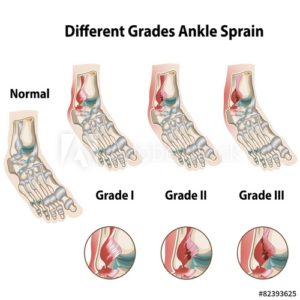Understanding Ankle Sprains
by Daniel Cox, DPT
AzOPT Glendale Doctor of Physical Therapy
Arizona is home to many outdoor activities like hiking, trail running, and other sports. But our desert terrain leads to one common injury – ankle sprains! While many of us just ice and hobble along until we feel ready to return to our favorite activities, some of us will take longer than expected to return to full speed. Regardless, in order to prevent an ankle sprain from lingering and becoming chronic, it is important to take an active role in your recovery by utilizing exercises that focus on range of motion, strength, and balance. These will help you recover not only faster, but stronger.
 Ankle sprains are graded by severity, the higher the grade – the longer the recovery. These are:
Ankle sprains are graded by severity, the higher the grade – the longer the recovery. These are:
Grade 1 – light sprains that usually allow return to activity in 2-3 weeks.
Grade 2 – ankle sprains involve greater injury to the ligament and can take up 4-6 weeks to allow full return.
Grade 3 – injuries are more severe in nature and often involve full tearing of the ligament. The length of time to recover from grade 3 ankle sprains could be 3 months or more.
Inability to walk on the injured ankle, or severe swelling and bruising are good indications that the injury is severe and you should seek medical attention from a physical therapist or healthcare professional.
Whichever grade of sprain, it is important that you undergo rehab to ensure a safe return to your activity and minimize the risk of re-injury. Focusing on your range of motion, strength, balance, and stability are core areas that will address the demands of any sport or activity.
Maintaining range of motion is vitally important. In light ankle sprains, a few days of taking it easy and some gentle motion is enough. In the most severe ankle sprains, a period of immobilization might be required. Once allowed, you should start to move your ankle as soon as possible. Your physical therapist will be able to provide exercises and perform manual techniques that can expedite the process. Lacking range of motion can put unnecessary stress on other ankle/lower limb structures when your return to sport and can cause re-injury.
It is important your ankle is strong as well; not only the muscles that control your ankle, but also the ligaments and tendons that support your ankle and foot. The level of strength required within an ankle varies between different activities. Simple exercises might be enough in the early stages, but single leg heel raises and single leg hopping exercises may also be included in the program depending on the requirements of the goal activity. It is also possible that other leg and hip muscles may be weak and need training to support your return to activity.
The last factor is balance and proprioception- or position sense. Many people can have very strong ankles with good range of motion and feel ready to return to sport. However, without good balance you are at increased risk of re-injury. When you sprain a ligament it affects some of the sensors within the joint that provide feedback to your brain about where your foot is and how it’s stressed. These are important, as they provide valuable information on how to protect itself.
Balance and proprioception allows you to run down an uneven trail and prevent you falling. It allows you to be able to correct your foot position when you feel like you might be about to roll over on your ankle. This is most often not a conscious thing that you do but an automatic loop that goes through your brain. Balance and proprioception exercises are developed through slowly increasing difficulty. Initially, you may stand on one leg on level ground and eventually end up standing on a foam cushion or balance board with eyes closed. Hopping on one leg through obstacle courses and other single leg hopping exercises are also another good way to work on your ankle proprioceptive system.
In addition to manual techniques and exercise, your physical therapist may offer taping to support your ankle. This is usually a short term strategy, and it is important that you do not become dependent on these. In certain circumstances where the ligaments are very lax, wearing a supportive brace might be a good idea. However, your physical therapist or doctor will advise you on this.
Finally, it is common for some residual swelling and very mild aching or dull pain to remain within the ankle joint in the latter stages of rehab. Ideally, you should not have swelling after activity, and pain should not be sharp, stabbing or severe, or persist long after activity. Consulting with your physical therapist or doctor is vital on returning to activity if you have questions. Taking an active role and addressing the injury early will lead to a much swifter rehab and enable you to get back to activity or sports much quicker.







